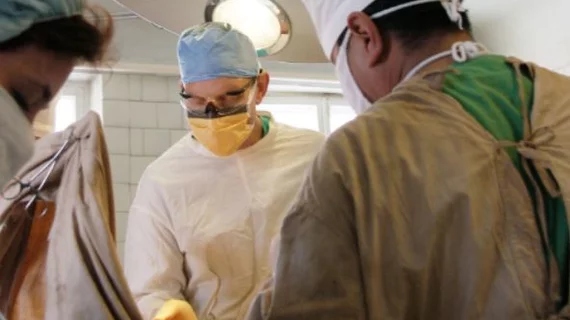One in five patients who required emergency surgery to correct complications caused by diagnostic angiography or percutaneous coronary intervention (PCI) died within 30 days, researchers reported in a single-center study from Germany.
However, 64 percent of individuals who survived beyond that point were alive five years later, which “justifies tremendous efforts at performing these emergency operations,” wrote Marc Ruel, MD, MPH, and Alessandro Affronti, MD, PhD, with the University of Ottawa Heart Institute, in a related editorial published in the Journal of the American Heart Association.
Senior study author Piroze M. Davierwala, MD, and colleagues studied data from 168 patients who underwent cardiac surgical procedures to correct iatrogenic complications from PCI or diagnostic coronary angiography. The report included a mean follow-up of 5.6 years—with some patients being tracked for more than 16 years—and represents the only study to evaluate long-term outcomes in patients undergoing emergency surgery for these complications, according to the authors.
Type A aortic dissection was present in 7.7 percent of the cases, while PCI complications affected the left anterior descending (38.7 percent), right coronary (29.2 percent), circumflex (13.1 percent) and left main coronary arteries (19.0 percent).
A total of 20.8 percent of patients died in the hospital or within 30 days of their operations, while five- and 10-year mortality were 64 and 50 percent, respectively. However, those who survived beyond that initial 30-day period showed survival of 79 percent at five years and 64 percent at 10 years.
“After exclusion of operative mortality from the analysis, (five-year survival) was comparable if not better than that seen in non‐STEMI patients following CABG,” Davierwala et al. wrote. “This demonstrates that the most crucial period that determines the survival in patients undergoing corrective surgery is the perioperative period, particularly the time interval between the occurrence of a complication after PCI and surgery.”
The authors found that a critical state before the corrective surgery was the only independent predictor of operative mortality, carrying a 3.5-fold risk of that outcome after multivariable adjustment. Long-term mortality was impacted both by a critical preoperative state and coronary artery occlusion during PCI, which was associated with 2.6 times the risk of death.
Only 0.08 percent of patients undergoing diagnostic angiography or PCI at the authors’ institution between December 1999 and July 2015 required emergency surgery, a low proportion they attributed to the availability of more sophisticated guidewires and stents, improvements in bail-out stenting procedures and the growing experience and competence of interventional cardiologists who are capable of achieving low complication rates.
“Therefore, surgical treatment is needed only in cases of catastrophic unpredictable events that cannot be adequately managed by interventional methods, such as over‐stenting for localized coronary artery dissection, coronary artery balloon occlusion in cases of Ellis Class I or II coronary perforations, or pericardiocentesis for a hemopericardium,” Davierwala and coauthors wrote.
The researchers noted the retrospective design of their study could be considered a limitation, but it’s nearly impossible to perform a randomized trial for these emergency clinical scenarios, making such retrospective studies “the best possible evidence.”
The editorialists said this study highlights the importance of preventing these events in the first place as well as the urgency of performing quick interventions when corrective surgery is necessary.
“Because morbidity and mortality in this subpopulation of patients remain significantly high, it is of uttermost importance to have well‐established protocols for fast and effective transfer to a cardiac surgical facility, be it in-hospital or offsite,” Ruel and Affronti wrote. “On the basis of the data presented by (Davierwala) and colleagues, such efforts are likely to be worthwhile and lead to prolonged survival.”

